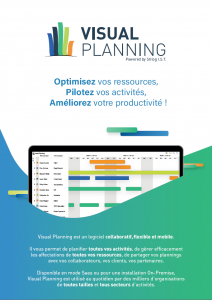Labor costs can significantly impact a company’s profitability, making it essential for businesses to optimize these costs and processes. A scheduling software, such as Visual Planning, can help streamline operations, reduce expenses, and improve efficiency, making it a powerful tool in achieving these goals. However, it’s important to remember that simply using these tools is not enough to achieve maximum labor cost reduction. In this article, we will explore some tips on how to reduce labor costs and improve productivity.
1. Forecast Labor Needs

Accurately forecasting workplace needs is a way to reduce labor costs. By accurately predicting the number of employees needed for each shift, businesses can make informed decisions about how to allocate their labor budgets and plan around employee schedules. Proper forecasting takes into account a range of factors, including historical data on employee availability and performance, as well as current and upcoming business needs. By analyzing these data points, businesses can determine the optimal number of employees to schedule for each shift and ensure that they have the necessary skills and expertise to perform their job duties effectively.
For instance, a hospital administrator can use forecasting tools to predict patient flow based on historical data and expected future trends. This allows the administrator to schedule the appropriate number of medical employees for each shift, assign them to specific roles, and ensure that the hospital is adequately staffed to meet patient needs. By using forecasting tools to optimize schedules, hospitals and medical clinics can improve patient outcomes, increase staff satisfaction, and reduce costs.
2. Support Collaboration and Engagement

Optimizing employee schedules is a way to reduce employment costs. However, to achieve this, businesses must support collaboration and engagement among their employees. This involves including employees in the scheduling process and reducing miscommunication and errors. With software like Visual Planning, businesses can create schedules that are more likely to be met with employee satisfaction and commitment.
For instance, a retail store can improve engagement by allowing employees to set their availability and preferences, providing shift-swapping options, and using an open communication platform between employees and managers. By supporting a collaborative and engaging culture, businesses can reduce scheduling errors and enhance processes to improve overall business operations. This can lead to better customer service, higher employee retention, and improved profitability. Also, employees who are involved in the scheduling process are likely to feel valued and motivated, leading to increased job satisfaction and higher levels of productivity.
3. Leverage Analytics and Reporting Features

Analytics and reporting features are powerful tools that provide businesses with valuable insights into their employees’ schedules, enabling them to improve productivity and reduce operating costs. By tracking attendance and punctuality, employers can identify patterns and trends that may indicate the need for further training or changes in work policies. Additionally, analytics and reporting features also allow businesses to monitor employment costs against budgets to identify opportunities for cost savings and adjust their budgets accordingly. Visual Planning’s software allows you to get real-time reporting insights from the field.
For example, a manufacturing plant can monitor the productivity of their workers and identify any inefficiencies in their processes. The manager can generate reports to make data-driven decisions and therefore, optimize their workforce and reduce both direct and indirect costs. This can include identifying which individuals are consistently underperforming and taking steps to address the issue, such as offering additional training or adjusting their workload. With this approach, the manufacturing plant can improve productivity, reduce operating costs, and maintain optimal labor expenses.
4. Streamline Scheduling Processes With Automation

Automating tasks such as shift assignments, shift reminders, and notifications of schedule changes can lower operating costs. This type of automation can save significant amounts of time and reduce errors that could result in unnecessary labor costs. Moreover, automating these tasks not only saves resources but can also lead to cost savings by improving the accuracy and efficiency of workforce management. With more accurate shift assignments and reminders, employees are more likely to show up on time and be available to work, reducing the risk of labor costs incurred due to unplanned absenteeism or tardiness.
For example, a restaurant can streamline its processes to automate tasks such as shift scheduling, shift reminders, and schedule changes. By automating these tasks, the restaurant can save time and reduce errors, ensuring that the right people are scheduled for the right shifts. This helps minimize these costs and improve overall operational efficiency.
5. Offer Flexible Scheduling

Flexible scheduling options can have a positive impact on employee morale and job satisfaction, leading to increased efficiency and engagement. When employees have more control over their schedules, they may feel more valued and empowered, leading to greater loyalty and reduced turnover rates. Nevertheless, companies can benefit from reduced overhead costs associated with recruiting and training new hires, which can be substantial when turnover rates are high.
For example, a software development company can cater to individual working preferences and promote a healthier work-life balance by allowing employees the option to work flexible hours or remotely. This approach can boost morale and motivation, leading to greater productivity. Additionally, it can help the company attract and retain top talent in a highly competitive industry.
6. Monitor Compliance with Labor Laws and Regulations

Scheduling software can help companies stay compliant with labor laws and regulations, such as minimum wage and overtime rules, by monitoring and flagging potential violations. This can be especially valuable for companies that operate across different regions or have complex labor laws to navigate. By avoiding legal costs, fines, and penalties, companies can free up resources to invest in other areas of the business, while also building a reputation as a responsible and compliant employer.
A transportation company may use this software to ensure drivers are not exceeding their allotted hours of service, which can result in fines and other penalties. This can also help improve safety on the road by ensuring that drivers are well-rested and not fatigued from overwork. The software can automatically track the hours that each driver works and alert managers when a driver is approaching the maximum allowed hours. This not only helps to ensure compliance with labor laws but also helps to prevent accidents due to driver fatigue.
7. Provide Real-Time Performance Feedback

Real-time performance feedback is an essential component of workforce management that can help employees make adjustments and improvements to their work. Moreover, using scheduling software can streamline the feedback process, making it easier for managers to track performance in real-time and provide feedback instantly. This ensures that employees are aware of their progress and can adjust their work accordingly to meet their goals, ultimately resulting in cost savings and improved business outcomes.
For example, if a customer service representative is not providing satisfactory service, the manager can provide feedback on the spot, allowing the individual to make the necessary changes before they repeat the same mistake. When employees receive timely and constructive feedback, they are better equipped to understand their strengths and weaknesses, and make changes that increase productivity and reduce errors. This, in turn, can boost employee morale and lead to a more positive work environment.
How to Track and Analyze Costs with Visual Planning

The importance of tracking the costs of labor cannot be overstated. In many industries, it is the largest expense, and any savings in this area can have a significant impact on the bottom line. Managers can also identify areas where costs can be reduced, such as identifying and addressing inefficiencies or reallocating resources.
Visual Planning’s scheduling software provides a comprehensive solution for labor cost analysis and tracking, making it a must-have tool for any manager. The software’s automated time-tracking feature helps monitor work hours to avoid instances of overtime and missed breaks. Meanwhile, the task management tools enable managers to assign specific tasks and monitor their progress in real-time. By offering a clear overview of productivity, managers can identify areas for improvement and even improve employee retention. Furthermore, the software’s resource allocation tools optimize productivity by allowing managers to assign tasks based on availability, skills, and workload while minimizing labor costs. The real-time insights enable managers to make informed decisions that can drive business success.
Start Boosting Your Bottom Line With Employee Scheduling Software

Efficient labor cost tracking is a crucial aspect of effective workforce management. With the proper scheduling software, managers can easily track, analyze, and reduce costs in real-time, helping them make informed decisions. Visual Planning’s employee scheduling software offers an all-in-one solution for managers to efficiently manage their workforce and optimize productivity. With automated time tracking, task management, and resource allocation features, it is a valuable tool for any manager looking to improve their workforce management practices and drive business success. Don’t let inefficiencies in workforce management cost your business money. Book a demo to learn how to reduce labor costs with Visual Planning.
Visual Planning is available on premise or in the cloud. Find out more about all Visual Planning features here, or read our case studies to understand how we are helping many companies to leverage their inner strengths.
Communicator Journalist with an Organizational Communication master degree specialized in Digital Communication from Jean Moulin Lyon 3 University. Passionate about new technologies, social medias, marketing and cooking.



